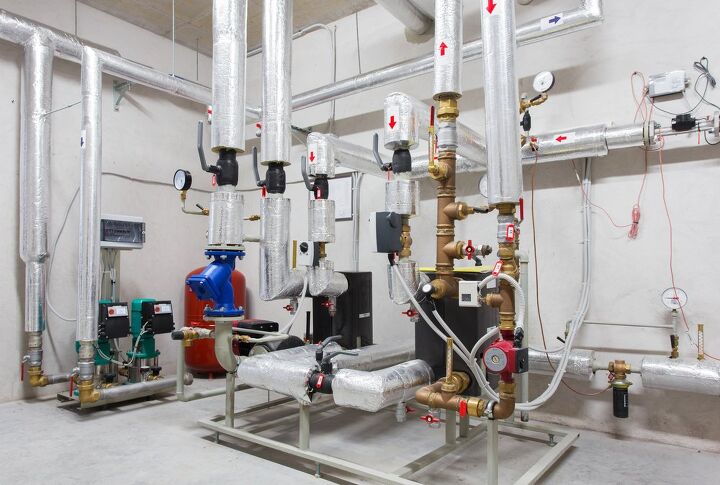How Does Plumbing Work In An Apartment Building?

Apartment buildings have taken over much of the United States and currently house millions of people across the country. What many people don’t think about is that every single apartment has to get their plumbing and electricity from somewhere. So, how does the plumbing work in an apartment building, and where does it come from?
The plumbing in an apartment building consists of two sets of pipes. Those that bring fresh water into the building and a set of pipes that takes wastewater away. Each apartment inside the building has a subset of pipes that do these same functions. One set of lines brings clean water into your apartment, and the other set takes dirty water away.
Plumbing in an apartment building comes with its own set of problems and complications. If you live in an apartment or are thinking about moving into one, this article will tell you all you need to know about your plumbing.
Do You Need to Hire a Plumber?
Get free, zero-commitment quotes from pro contractors near you.

How Does Plumbing Work in an Apartment Building?
The plumbing system in your apartment building works the same as any other type of plumbing system. The main difference is that it’s on a much larger scale than in a house or other building with only one system. Here’s the way that water gets into your apartment and then leaves.
- The main water line enters the apartment building, usually in the basement or lower level.
- A series of smaller water lines branch off to each apartment and feed them fresh water.
- In most cases, each apartment has its water meter so that your landlord knows how much to charge for your monthly water bill.
- After using water in your tubs, sinks, toilets, and anywhere else, it goes down a drain and leaves your building.
- Water leaves your apartment through a series of pipes called drain pipes.
- Each apartment has its own set of drain pipes that connect into a single, larger group of drains at the bottom of the building.
- While freshwater uses water pressure to travel wherever it needs to go, drains slope downhill and use gravity to leave your building.
- Each apartment can control its water and drainage independent of the other tenants. However, all of an apartment’s water comes and goes to and from the same place.
More extensive and taller apartment buildings operate the same way smaller buildings do, but with one difference. These buildings require multiple freshwater and wastewater systems to reach the higher apartments. However, no matter how many systems there are, the method of getting water to and from an apartment doesn’t change.
Explainer Video: How Your Home Plumbing Works (From Start to Finish)
Components of an Apartments Plumbing System
Vents
Vent pipes are necessary to balance out your apartment’s plumbing system. Every drain pipe must be connected to a vent pipe that carries air out of your building. Without vent pipes, your plumbing system would clog more often than it does already.
Traps
Traps are mandatory underneath sinks, toilets, and bathtubs to prevent water from backing up into your home.
Shutoff Valves
As the name implies, shutoff valves are there in case you need to turn the water off to the entire apartment or building. In the case of leaks or water pipe repairs, shutoff valves are a lifesaver.
Gravity Tanks
Gravity tanks sit on top of multi-level apartment buildings and provide freshwater to the apartments below. They’re necessary when apartments are too high for water pressure from the basement to reach them.
Water Pipes
Water pipes are the individual lines that carry freshwater to each of your plumbing appliances. Your toilets, showers, sinks, and anywhere else you have water will have a cold and usually a hot water line running to it.
Drain Lines
Anywhere that you use water, there has to be a drain line to carry it away. Otherwise, you would constantly be dealing with flooding issues.
Risers
For apartment buildings where every apartment gets water from the basement, risers get it there. They carry freshwater from one floor to another in smaller, multi-level buildings.
How do Apartment Sewer Systems Work?
Have you ever wondered where all the wastewater that you create goes? How wastewater is disposed of varies from place to place. In rural areas and locations outside of the city, a septic tank receives all the wastewater from a house. In urban areas, which includes most apartments, wastewater is carried through a series of pipes to a water treatment facility.
At the water treatment facility, wastewater goes through a series of treatments where water is separated from solids. Once the wastewater has been cleaned to the best of its ability, purified, and detoxified, it’s released into a river or body of water. For this reason, water treatment facilities are usually located in low areas near a body of water, usually a river.
The drain pipes in an apartment building are responsible for carrying sewage and wastewater out of the building. From there, they travel down large pipes, usually located below streets. The manhole covers that you see while walking down the streets act as vents. In larger cities like New York and Los Angeles, the sewer pipes located below the street are large enough to walk around in. In smaller cities, these pipes are anywhere from 3-5 feet in diameter.
At any rate, each apartment in your building has its own set of drain pipes. These pipes either connect into one large set of pipes in the bottom of your apartment building, or they connect to the cities sewer system on their own.
Common Plumbing Issues in an Apartment Building
Because of how many components are involved in an apartment’s plumbing, there are a ton of things that can go wrong. Here are some of the main things to be on the lookout for if you rent or own an apartment.
Bathroom Flooding and Ceiling Damage
Apartments are unique in that you can get flooding from any direction. The apartment above you can flood and cause ceiling damage, your own bathroom can flood, or an apartment next to you can flood and leak into your area. Flooding problems often result from a busted water pipe or from a severe backup. What makes apartment flooding unique is that it isn’t always your fault. It can be the result of a neighbor or careless landlord.
Water Heater Problems
In most cases, each individual apartment will have its own water heater. With so many water heaters in one area, there’s bound to be a problem somewhere along the way. Leaks, clogs, and dirty water are the most common issues to expect with your apartment’s water heater.
Dirty Water in Your Sinks or Tubs
If you’re getting dirty water coming out of your faucets, you likely have a bad water heater or dirty pipes. Many older apartments used cast iron or steel for their water pipes which are prone to rusting and breaking down from the inside out.
Drain Clogs
Another common mishap for houses and apartments alike is draining clogs. Clogs can occur because you put something down your drain that you shouldn’t have or from a bad pipe. Older apartments used cast iron for their drain pipes which are notorious for breaking apart from the inside out. The outside of the pipe will look fine, but the inside is corroding, which can cause clogs.
Related Questions
Who’s responsible for fixing pipes in an apartment building?
If there are damaged water or drain pipes in your apartment building, it depends on where the pipe is located. If you own the apartment with the damaged pipe, it’s your responsibility to repair it. However, if you’re a renter, your landlord is responsible for fixing it.
Do shower water and toilet water go to the same place?
All wastewater, including shower water, toilet water, and sink water, goes to the same place. Whether it’s a septic tank or a water treatment facility depends on the structure of your sewage system.
Do You Need to Hire a Plumber?
Get free, zero-commitment quotes from pro contractors near you.

Final Thoughts
Well, there you have it, everything you need to know about your apartment’s plumbing system. Knowing how your system works will help you be able to identify problems and fix them. It will also help you be better informed about how your building functions as a whole.

Before I started writing, I worked for 6 plus years in the plumbing, electrical, and HVAC business. I was primarily an HVAC installer but also worked as a plumber and electrician. Now I'm a copywriter, focusing on home improvement content and guides.
More by Jalin Coblentz










![How Much Weight Can a 4×4 Support Horizontally? [It Depends!]](https://cdn-fastly.upgradedhome.com/media/2023/07/31/9070333/how-much-weight-can-a-44-support-horizontally-it-depends.jpg?size=350x220)
















